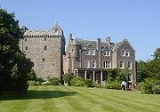
Comlongon Castle
Encyclopedia

Tower house
A tower house is a particular type of stone structure, built for defensive purposes as well as habitation.-History:Tower houses began to appear in the Middle Ages, especially in mountain or limited access areas, in order to command and defend strategic points with reduced forces...
dating from the 15th century. It is located 1 km west of the village of Clarencefield
Clarencefield
-External links:***...
, 10 km south-east of Dumfries
Dumfries
Dumfries is a market town and former royal burgh within the Dumfries and Galloway council area of Scotland. It is near the mouth of the River Nith into the Solway Firth. Dumfries was the county town of the former county of Dumfriesshire. Dumfries is nicknamed Queen of the South...
, in south west Scotland
Scotland
Scotland is a country that is part of the United Kingdom. Occupying the northern third of the island of Great Britain, it shares a border with England to the south and is bounded by the North Sea to the east, the Atlantic Ocean to the north and west, and the North Channel and Irish Sea to the...
. The original tower was extended by the addition of a 19th century baronial style
Scottish baronial style
The Scottish Baronial style is part of the Gothic Revival architecture style, using stylistic elements and forms from castles, tower houses and mansions of the Gothic architecture period in Scotland, such as Craigievar Castle and Newark Castle, Port Glasgow. The revival style was popular from the...
mansion. The castle and mansion are now a hotel.
History
Thomas Randolph, 1st Earl of Moray granted the lands of Comlongon, in the early 14th century, to his nephew William de Moravia, ancestor of the Murrays of Cockpool. His descendant Cuthbert of Cockpool (d.1493) built Comlongon Castle in the later part of the 15th century, to replace the Murrays' earlier castle of Cockpool, of which only earthworks remain at Cockpool Farm, to the south west of Comlongon. His son John Murray (d. c.1527) was created Baron Cockpool in 1508. Descendants of the Murrays were later created Viscounts StormontViscount of Stormont
Viscount Stormont is a title in the Peerage of Scotland. It was created in 1621 by James VI for his friend and helper Sir David Murray who had saved him from the attack of Earl Gowrie in 1600. Murray had already been created Lord Scone, also in the Peerage of Scotland in 1605...
in 1621, and Earls of Mansfield in 1776, and Comlongon was part of the Earl's estate until 1984.
The castle is reportedly haunted by the ghost of Lady Marion Carruthers who took her own life by leaping from the lookout tower.
The castle
The red sandstone tower is approximately 15m by 13m, and 18m high to the corbelled parapet. It was built on a stone 'plinth', in order to support the structure on what was a marshy site. The entrance to the tower still retains the original yettYett
A yett is a gate or grille of latticed wrought iron bars used for defensive purposes in castles and tower houses...
, a portcullis-like metal grid in front of the door. This leads into a vaulted cellar with a well, and two spiral stairs leading up. The main stair at the north-east corner leads up to a caphouse at parapet level, while the second serves the high-table end of the first floor hall.
The hall is dominated by a large fireplace, with the Royal Arms of Scotland
Royal coat of arms of Scotland
The royal coat of arms of Scotland was the official coat of arms of the monarchs of Scotland, and was used as the official coat of arms of the Kingdom of Scotland until the Acts of Union of 1707...
carved above it. Heraldic emblems are carved onto several projecting corbels, and an elaborately decorated recess or aumbry
Aumbry
In the Middle Ages an aumbry was a cabinet in the wall of a Christian church or in the sacristy which was used to store chalices and other vessels, as well as for the reserved sacrament, the consecrated elements from the Eucharist. This latter use was infrequent in pre-Reformation churches,...
, with a carved cinquefoil surround, attests to the relative wealth of the Murrays. A separate fireplace at the opposite end of the hall would have served the narrow kitchen, and would have been separated from the hall by a timber screen where a wall now stands.
The most remarkable feature of Comlongon is the walls, over 4m thick in places, and riddled with numerous interconnecting chambers to an extent not seen in any contemporary Scottish castle. The narrow kitchen is one such mural chamber. Also within the walls off the hall is a guardroom, with a cell beyond, and a trapdoor which gives access to a grim unlit dungeon below.
Two further storeys lie above the hall, with parapet walks at roof level. The western parapet was roofed over before 1624, when a surviving inventory was taken, creating a gallery with crow-stepped gables. A similar structure was built over the south-east corner, giving the south facade a symmetrical appearance. The upper storeys were also subdivided before this time.
A walled courtyard and ditch, possibly a moat, once surrounded the tower, although this was removed in the early 18th century, when a manor house was added to the east side of the tower. Between 1890 and 1902 this manor was replaced by the present Scottish baronial mansion, by architects James Barbour & JM Bowie of Dumfries. The castle was bought by the present owners, from the Earl of Mansfield's estate, in 1984, and renovated to its current condition. It has been operated as a hotel since then.

